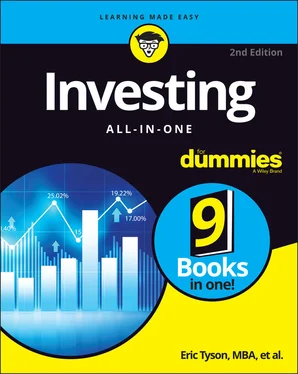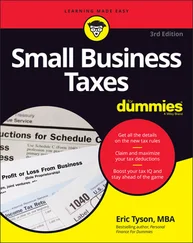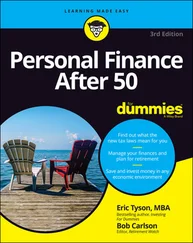Eric Tyson - Investing All-in-One For Dummies
Здесь есть возможность читать онлайн «Eric Tyson - Investing All-in-One For Dummies» — ознакомительный отрывок электронной книги совершенно бесплатно, а после прочтения отрывка купить полную версию. В некоторых случаях можно слушать аудио, скачать через торрент в формате fb2 и присутствует краткое содержание. Жанр: unrecognised, на английском языке. Описание произведения, (предисловие) а так же отзывы посетителей доступны на портале библиотеки ЛибКат.
- Название:Investing All-in-One For Dummies
- Автор:
- Жанр:
- Год:неизвестен
- ISBN:нет данных
- Рейтинг книги:3 / 5. Голосов: 1
-
Избранное:Добавить в избранное
- Отзывы:
-
Ваша оценка:
- 60
- 1
- 2
- 3
- 4
- 5
Investing All-in-One For Dummies: краткое содержание, описание и аннотация
Предлагаем к чтению аннотацию, описание, краткое содержание или предисловие (зависит от того, что написал сам автор книги «Investing All-in-One For Dummies»). Если вы не нашли необходимую информацию о книге — напишите в комментариях, мы постараемся отыскать её.
Investing All-in-One For Dummies
.
Dummies
Investing All-in-One For Dummies
Investing All-in-One For Dummies
Investing All-in-One For Dummies — читать онлайн ознакомительный отрывок
Ниже представлен текст книги, разбитый по страницам. Система сохранения места последней прочитанной страницы, позволяет с удобством читать онлайн бесплатно книгу «Investing All-in-One For Dummies», без необходимости каждый раз заново искать на чём Вы остановились. Поставьте закладку, и сможете в любой момент перейти на страницу, на которой закончили чтение.
Интервал:
Закладка:
When you sell shares in a mutual fund, the IRS has yet another accounting method, known as the average cost method, for figuring your taxable profit or loss. This method comes in handy if you bought shares in chunks over time or reinvested the fund payouts in purchasing more shares of the fund. As the name suggests, the average cost method allows you to take an average cost for all the mutual fund shares you bought over time.
Selling large-profit investments
No one likes to pay taxes, of course, but if an investment you own has appreciated in value, someday you’ll have to pay taxes on it when you sell. (There is an exception: You hold the investment until your death and will it to your heirs. The IRS wipes out the capital gains tax on appreciated assets at your death.)
Capital gains tax applies when you sell an investment at a higher price than you paid for it. As explained earlier in this chapter, your capital gains tax rate is different from the tax rate that you pay on ordinary income (such as from employment earnings or interest on bank savings accounts).
Odds are that the longer you’ve held securities such as stocks, the greater the capital gains you’ll have, because stocks tend to appreciate over time. If all your assets have appreciated significantly, you may resist selling to avoid taxes. If you need money for a major purchase, however, sell what you need and pay the tax. Even if you have to pay state as well as federal taxes totaling some 35 percent of the profit, you’ll have lots left. (For “longer-term” profits from investments held more than one year, your federal and state capital gains taxes probably would total somewhat less.)
 Before you sell, do some rough figuring to make sure you’ll have enough money left to accomplish what you want. If you seek to sell one investment and reinvest in another, you’ll owe tax on the profit unless you’re selling and rebuying real estate.
Before you sell, do some rough figuring to make sure you’ll have enough money left to accomplish what you want. If you seek to sell one investment and reinvest in another, you’ll owe tax on the profit unless you’re selling and rebuying real estate.
 If you hold several assets, to diversify and meet your other financial goals, give preference to selling your largest holdings with the smallest capital gains. If you have some securities that have profits and some with losses, you can sell some of each to offset the profits with the losses.
If you hold several assets, to diversify and meet your other financial goals, give preference to selling your largest holdings with the smallest capital gains. If you have some securities that have profits and some with losses, you can sell some of each to offset the profits with the losses.
Handling losers in your portfolio
Perhaps you have some losers in your portfolio. If you need to raise cash for some particular reason, you may consider selling select securities at a loss. You can use losses to offset gains as long as you hold both offsetting securities for more than one year (long term) or hold both for no more than one year (short term). The IRS makes this delineation because it taxes long-term gains and losses on a different rate schedule from short-term gains and losses.
If you sell securities at a loss, you can claim up to $3,000 in net losses for the year on your federal income tax return. If you sell securities with net losses totaling more than $3,000 in a year, you must carry the losses over to future tax years.
 Some tax advisors advocate doing year-end tax-loss selling with stocks, bonds, and mutual funds. The logic goes that if you hold a security at a loss, you should sell it, take the tax write-off, and then buy it (or something similar) back. When selling investments for tax-loss purposes, be careful of the so-called wash sale rules. The IRS doesn’t allow the deduction of a loss for a security sale if you buy that same security back within 30 days. As long as you wait 31 or more days, you won’t encounter any problems.
Some tax advisors advocate doing year-end tax-loss selling with stocks, bonds, and mutual funds. The logic goes that if you hold a security at a loss, you should sell it, take the tax write-off, and then buy it (or something similar) back. When selling investments for tax-loss purposes, be careful of the so-called wash sale rules. The IRS doesn’t allow the deduction of a loss for a security sale if you buy that same security back within 30 days. As long as you wait 31 or more days, you won’t encounter any problems.
 If you’re selling a mutual fund or exchange-traded fund, you can purchase a fund similar to the one you’re selling to easily sidestep this rule.
If you’re selling a mutual fund or exchange-traded fund, you can purchase a fund similar to the one you’re selling to easily sidestep this rule.
Selling investments when you don’t know their original cost
Sometimes, you may not know what an investment originally cost you, or you received some investments from another person, and you’re not sure what they paid for them.
If you don’t have the original statement, start by calling the firm where the investment was purchased. Whether it’s a brokerage firm or mutual fund company, the company should be able to send you copies of old account statements, although you may have to pay a small fee for this service.
Also, increasing numbers of investment firms, especially mutual fund companies, can tell you upon the sale of an investment what its original cost was. The cost calculated is usually the average cost for the shares you purchased.
Chapter 3
Laying Out Your Financial Plans
IN THIS CHAPTER
 Knowing what you should do before investing
Knowing what you should do before investing
 Understanding how your financial plan translates into your investing plan
Understanding how your financial plan translates into your investing plan
 Protecting your assets with insurance
Protecting your assets with insurance
Before you make any great, wealth-building investments, you should get your financial house in order. Understanding and implementing some simple personal financial management concepts can pay off big for you in the decades ahead. This chapter explains what financial housekeeping you should do before you invest, as well as how to translate your overall personal and financial plans into an investment plan and ways to protect yourself and your property.
First Priorities: Paying Off High-Cost Debt and Building a Safety Reserve
Plenty of younger adults have debts to pay and lack an emergency reserve of money for unexpected expenses. High-cost debts, such as on a credit card, can be a major impediment to investing, in particular, and accomplishing your future personal and financial goals, in a broader sense. A high interest rate keeps the debt growing and can cause your debt to spiral out of control, which is why the following sections discuss dealing with such consumer debt as your first priority, just before establishing an emergency reserve.
Paying off high-cost consumer debt
Paying down debts isn’t nearly as exciting as investing, but it can make your investment decisions less difficult. Rather than spending your time investigating specific investments, paying off your debts with money you’ve saved may indeed be your best investment.
Consumer debt includes borrowing on credit cards, auto loans, and the like, which are often costly ways to borrow. Banks and other lenders charge higher interest rates for consumer debt than for debt for investments, such as real estate and business, because consumer loans are the riskiest type of loans for a lender. Risk means the chance of the borrower’s defaulting and being unable to pay back all that they borrowed.
Many folks have credit card debt that costs 18 percent or more per year in interest. Some credit cards levy interest rates well above 20 percent if you make a late payment or two. Reducing and eventually eliminating this debt with your savings is like putting your money in an investment with a guaranteed tax-free return equal to the rate that you pay on your debt.
Читать дальшеИнтервал:
Закладка:
Похожие книги на «Investing All-in-One For Dummies»
Представляем Вашему вниманию похожие книги на «Investing All-in-One For Dummies» списком для выбора. Мы отобрали схожую по названию и смыслу литературу в надежде предоставить читателям больше вариантов отыскать новые, интересные, ещё непрочитанные произведения.
Обсуждение, отзывы о книге «Investing All-in-One For Dummies» и просто собственные мнения читателей. Оставьте ваши комментарии, напишите, что Вы думаете о произведении, его смысле или главных героях. Укажите что конкретно понравилось, а что нет, и почему Вы так считаете.












